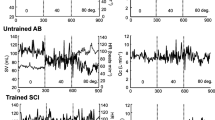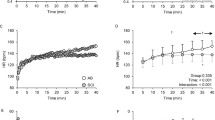Summary
The purpose of this study was to examine cardiovascular responses during arm exercise in paraplegics compared to a well-matched control group. A group of 11 male paraplegics (P) with complete spinal cord-lesions between T6 and T12 and 11 male control subjects (C), matched for physical activity, sport participation and age performed maximal arm-cranking exercise and submaximal exercise at 20%, 40% and 6070 of the maximal load for each individual. Cardiac output (Q c) was determined by the CO2 rebreathing method. Maximal oxygen uptake was significantly lower and maximal heart rate (f c) was sigificantly higher in P compared to C. At the same oxygen uptakes no significant differences were observed inQ c between P and C; however, stroke volume (SV) was significantly lower andf c significantly higher in P than in C. The lower SV in P could be explained by an impaired redistribution of blood and, therefore, a reduced ventricular filling pressure, due to pooling of venous blood caused by inactivity of the skeletal muscle pump in the legs and lack of sympathetic vasoconstriction below the lesion. In conclusion, in P maximal performance appears to have been limited by a smaller active muscle mass and a lower SV despite the higher ϕc,max. During submaximal exercise, however, this lower SV was compensated for by a higherf c and, thus at the same submaximal oxygen uptake,Q c was similar to that in the control group.
Similar content being viewed by others
References
Bergh U, Kanstrup IL, Ekblom B (1976) Maximal oxygen uptake during exercise with various combinations of arm and leg work. J Appl Physiol 41:191–196
Binkhorst RA, Minderaa PH, Schellevis CI, Vissers ACA (1984) The physical work capacity of wheelchair basketball players (in dutch). Geneesk en Sport 17:78–79
Burkett LN, Chisum J, Stone W, Fernhall B (1990) Exercise capacity of untrained spinal cord-injured individuals and the relationship of peak oxygen uptake to level of injury. Paraplegia 28:512–521
Collier CR (1956) Determination of mixed venous CO2 tensions by rebreathing. J Appl Physiol 9:25–29
Compton DM, Eisenman PA, Henderson HL (1989) Exercise and fitness for persons with disabilities. Sports Medicine 7:150–162
Coutts KD, Rhodes EC, McKenzie DC (1985) Submaximal exercise responses of tetraplegics and paraplegics. J Appl Physiol 59:237–241
Davis GM, Shephard RJ (1988) Cardiorespiratory fitness in highly-active versus inactive paraplegics. Med Sci Sports Exerc 20:463–468
Davis GM, Servedio FJ, Glaser RM, Gupta SC, Suryaprasad AG (1990) Cardiovascular responses to arm-cranking and FNS-induced leg exercise in paraplegics. J Appl Physiol 69:671–677
De Bruin MI, Binkhorst RA (1984) Cardiac output of paraplegics during exercise. Int J Sports Med [Suppl] 5:175–176
Gass GC, Camp EM (1984) The maximum physiological responses during incremental wheelchair and arm-cranking exercise in male paraplegics. Med Sci Sports Exerc 16:355–359
Glaser RM (1985) Exercise and locomotion for the spinal cordinjured. Exerc Sport Sci Rev 13:263–303
Glaser RM, Sawka MN, Brune MF, Wilde SW (1980) Physiological responses to maximal effort wheelchair and arm-crank ergometry. J Appl Physiol 48:1060–1064
Guyton AC, Jones CE (1973) Central venous pressure: physiological significance and clinical implications. Am Heart J 86:431
Hjeltnes N (1977) Oxygen uptake and cardiac output in graded arm exercise in paraplegics with low level spinal lesions. Scand J Rehabil Med 9:107–113
Hjeltnes N, Vokac Z (1979) Circulatory strain in every day life of paraplegics. Scand J Rehabil Med 11:67–73
Hopman MTE, Oeseburg B, Binkhorst RA (1991) The effect of an anti-G suit on cardiac response in paraplegics and able-bodied subjects during arm exercise. Med Sci Sports Exerc [Suppl] 23:103
Jehl JL, Gandmontagne M, Pastene G, Eysette M, Flandrois R, Coudert J (1991) Cardiac output during exercise in paraplegic subjects. Eur J Appl Physiol 62:256–260
Jones NL, Campbell EJM, Edwards RHT, Wilkoff WG (1969) Alveolar-to-blood PCO2 difference during rebreathing in exercise. J Appl Physiol 27:356–360
Kinzer SM, Convertino VA (1989) Role of leg vasculature in the cardiovascular response to arm work in wheelchair-dependent populations. Clin Phys 9:525–533
Kwant G, Oeseburg B, Zwart A, Zijlstra WG (1987) Calibration of a practical haemoglobinometer. Clin Lab Haematol 9:387–393
McConnell TJ, Horvat MA, Beutel-Horvat TA, Golding LA (1989) Arm-crank versus wheelchair treadmill ergometry to evaluate the performance of paraplegics. Paraplegia 27:307–313
Sawka MN, Glaser RM, Wilde SW, Von Luhrte TC (1980) Metabolic and circulatory responses to wheelchair and arm crank exercise. J Appl Physiol 49:784–788
Sawka MN (1986) Physiology of upper-body exercise. Exerc Sport Sci Rev 14:175–211
Shephard RJ (1988) Sports medicine and the wheelchair athlete. Sports Med 5:226–247
Van Herwaarden CLA, Binkhorst RA, Fennis JFM, Van't Laar A (1980) Reliability of the cardiac output measurement with the indirect Fick-principle for CO2 during exercise. Pflügers Arch 385:21–23
Van Loan MD, McCluer S, Loftin JM, Boileau RA (1987) Comparison of physiological responses to maximal arm exercise among able-bodied, paraplegics and quadriplegics. Paraplegia 25:397–405
Washburn RA, Seals DR (1983) Comparison of continuous and discontinuous protocols for the determination of peak oxygen uptake in arm-cranking. Eur J Appl Physiol 51:3–6
Wick JR, Oldridge NB, Cameron BJ, Jones NL (1983) Armcranking and wheelchair ergometry in elite spinal cord-injured athletes. Med Sci Sports Exerc 15:224–231
Zwiren LD, Bar-Or O (1975) Responses to exercise of paraplegics who differ in conditioning level. Med Sci Sports Exerc 7:94–98
Author information
Authors and Affiliations
Rights and permissions
About this article
Cite this article
Binkhorst, R.A., Oeseburg, B. & Hopman, M.T.E. Cardiovascular responses in paraplegic subjects during arm exercise. Europ. J. Appl. Physiol. 65, 73–78 (1992). https://doi.org/10.1007/BF01466277
Accepted:
Issue Date:
DOI: https://doi.org/10.1007/BF01466277




